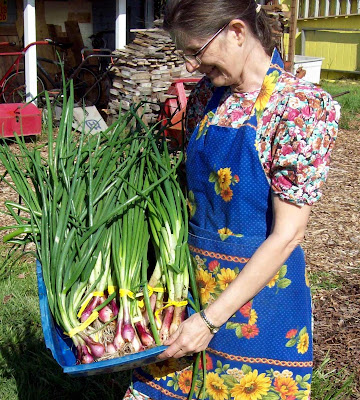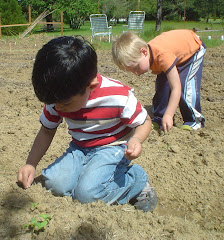 |
| Striped German - Heirloom tomato |
In order to save seeds that will "grow true" and produce fruit similar to the one you saved seeds from, you must start with an "heirloom" or "open-pollinated" (OP) variety (not hybrid). Hybrid seeds are artificially created by seed companies to produce plants with unique qualities (early ripening, bug resistance etc). The problem is that they don't "breed true". If you save seed from hybrids, next year's plants may or may not be what you want. If you wish to save seeds, choose seeds or starts that say "open pollinated", OP, heirloom or non-hybrid.
 |
| "Heirloom" tomatoes come in all types: here are large paste-tomatoes called "Long Toms" |
 | |
| Black Krim (below) and Striped German |
In saving seed, you wish to mimic nature's process. Have you ever noticed what happens to the tomatoes left in the garden after the first frost? They turn to a slimy mush, with the fruit eventually dissolving away from the seed. In the following year, robust little volunteers emerge from where the tomato rotted. The way we mimic this process: Remove the stem from your chosen tomato and put it in the blender with enough water to fill a quart jar. Whiz it in the blender, at a low speed, just long enough to separate seeds from fruit. Don't worry about the seeds. They have a protective gel that keeps the blades from harming them. Pour them into a wide-mouth glass jar. Be sure to swirl the blender as you pour the last liquid out so no seeds are left in the bottom. If you're processing more than one tomato variety in a row, rinse the blender well so you don't mix seed varieties. Label the jar so you remember the variety of seeds you're saving.
The next step is to leave them to "rot". To minimize fruit-flies secure a piece of cheese cloth over the opening with a rubber-band or canning-jar ring. Leave them in the open jar for 4-7 days. When it's warm outside, the process will go faster. Stir them once or twice a day with a chopstick to help separate the seed from the pulp. The pulp and non-viable seeds will form a layer at the top. The healthy seeds will sink to the bottom. Look for a nice scum to form on the top. Mold is OK. The picture on the left is of two varieties of tomato seeds in process. The ones on the right were just blended so no layers have formed. The ones on the left have been sitting a few days. The other picture shows the quality of the scum that has formed on the tomatoes once they are ready for the next step. Notice the bubbles which indicate a mild fermentation process.


The last step is to dry the seeds. Spoon out the scum and pour off most of the water. The viable seeds will have sunk to the bottom but be careful not to pour them out with the pulp/water. Add more water, allow to settle and continue to pour off excess flesh. Repeat this process till you've removed the majority of the flesh. Then pour the seeds through a fine-mesh strainer and rinse them in the strainer. Let them drip-dry and then tap them onto a piece of tin-foil, a jar-lid or other non-porous surface. We find that the lid to a plastic tub (like a yogurt container) works best as it's flexible and we can "pop" off the seeds after they've dried. Seeds will stick to paper towel or napkins. Transfer your label to the drying seeds and leave them to dry for a week or so. Be sure they are thoroughly dry before storage so they don't mold in the bag, envelope or jar.
Each seed-saver has his or her preference for containers to store seeds in. We use clean, small plastic bags or recycled plastic pill-bottles or other small jars. The most important thing is to keep your whole seed collection in a dry, dark environment with moderate temperatures, in air-tight containers. Avoid freezing or excessive heat. Stored well, tomato seeds can remain viable for many years.
 |
| Tomato seeds drying. |



















































